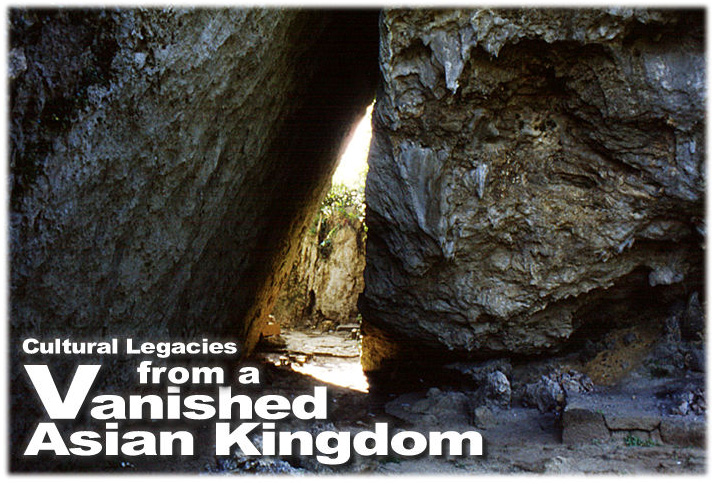Gusuku, Sonohyan Utaki, Tamaudun, Shikina-en, Sefa Utaki

Sefa-utaki
The most sacred place on the island. One of the seven original utaki created by the founding goddess of Ryukyu.
| The Castles of the Ryukyu Kingdom and other related monuments are being recommended for registration as World Heritage Sites. These are castle sites and related areas that were built from the unification of the Ryukyu Kingdom in the latter half of the 14th century through to the end of the kingdom in the late 18th century and represent the unique and distinctive culture of the Ryukyu Islands. The emphasis for registration is that, while relatively unknown to the world, they exist as important cultural legacies from a prosperous trading kingdom of ancient Asia. |
The term Gusuku is written with the Chinese character for castle. However, in Okinawa this term is used to designate not only fortresses but also tombs, sacred places for prayer, and early village communities. Of the nine sites being recommended for World Heritage status, five of them are castles: the reconstructed Shurijo Castle and the remains of Nakijin, Zakimi, Nakagusuku, and Katsuren castles. The remaining sites are not castles per-se but fall under the broader definition of cultural legacies. The first of these other sites is Tamaudun, built in 1501, which was the royal mausoleum of the second Sho Dynasty. The front courtyard is made of filled coral. The other site, Shikinaen Garden, was used to entertain Chinese investiture envoys. The most beautiful garden created in the Ryukyu Kingdom, it boasts an artificial pond in the shape of the character for Kokoro (Heart or Mind). The utaki or sacred groves of the Ryukyus are spiritual spaces and are considered another style of gusuku (literally translated as castle). The two utaki recommended as World Heritage sites, Sefa-utaki and Sonohyan-utaki are deeply related to beliefs in traditional Okinawan nature worship. Sefa-utaki is considered the most sacred of places and from it Kudaka Island, thought to be the island of the gods, is visible. The second, Sonohyan-utaki, was where the king would pray for a safe journey when he would depart Shurijo castle. The gate to the grove is constructed of stone except for the doors, which are of wood. Rebuilt after the destruction of WWII, they continue to be places of worship in the daily lives of the island's people. It is hoped that by receiving World Heritage Site status these legacies from the Ryukyu Kingdom will contribute to world culture through their spirituality and beauty. | Tamaudun mausoleum Bones of the royal family were placed in the three gabled tombs in the inner court. Shikina-en garden The largest country villa of the royal family built in the 18th century Sonohyan-utaki stone gate Prayers were offered for important ceremonies of the kingdom |
| Sonohyan Utaki Address: 7,1-chome, Mawashi, Naha City Okinawa, Japan TEL:+81-98-853-5776 (Naha City Board of Education) Free Admission Take city bus line #1,12,13,14,17 to the bus stop Ikehata | Tamaudun Address:3,1-chome,Kinjo-cho,Naha City Okinawa,Japan TEL:+81-98-885-2861 (Tamaudun Management Office) +81-98-853-5776 (Naha City Board of Education) Fees:Adult 200yen Children 100yen Hours: 9:00- 17:30 Take city bus line #1,12,13,14,17 to the bus stop Ikehata | Shikina-en Udunbaru, Naha City Okinawa, Japan TEL:098-855-5936 (Shikina-en Management Office) 098-853-5776 (Naha City Board of Education) Fees: Adult 300yen Children 100yen Hours:9:00~17:30 (from April to September) 9:00~17:00 (from October to March) Take city bus line #1,5 to the bus stop Shikina-en Mae and walk 2 minutes | Sefa Utaki Address: Sayaha-baru,2,Aza Kudeken,Chinen Village Okinawa,Japan TEL:+81-98-948-1413 (Chinen Village Office) +81-98-948-1149 (Chinen Village Board of Education) Free Admission Take bus #38 to the bus stop Taiiku Center Mae and walk 5 minutes |
It is the hope and pride of Okinawans to continue to pass on the culture created by our ancestors during the Ryukyu Kingdom and inherited by us. Last year, the Japan Agency for Cultural Affairs recommended that nine sites in Okinawa Prefecture, including Shuri-jo Castle, known collectively as the "Ryukyu Kingdom Gusuku Castles and Related Historic Sites", be registered as World Heritage Sites. The World Heritage program was created out of a convention adopted by signatories from 156 countries at the general meeting of UNESCO in 1972. This system was established to aid international cooperation in the protection and preservation of the world's natural and cultural legacies for the benefit of all humanity. The announcement regarding the registration of these sites is expected in December, 2000 and all Okinawans are eagerly awaiting what we hope will be a positive outcome This is the third in this series on the areas being nominated as World Heritage Sites. | ||
"Ryukyu Kingdom Gusuku Castles and Related Historic Sites" The sites under consideration for World Heritage Site status are comprised of two important cultural properties, seven historical sites, and one scenic spot. They were all constructed or established in between the late 14th century to the end of the 18th century, from the time of unification of the Ryukyu Kingdom through its dissolution. The group of sites expresses the distinct features of the history, culture and nature of the Ryukyu archipelago region. 1) Nakijin-jo Castle Remains (Kunigami-gun Nakijin-son Village) Designated Historical Site 2) Zakimi-jo Castle Remains (Nakagami-gun Yomitan-son Village) Designated Historical Site 3) Katsuren-jo Castle Remains (Nakagami-gun Katsuren-cho Village) Designated Historical Site 4) Nakagusuku-jo Castle Remains (Nakagami-gun Kita-Nakagusuku-son Nakagusuku-son Village) Designated Historical Site | 5) Shuri-jo Castle Remains (Naha City) Designated Historical Site 6) Sono-hiyan-utaki Ishimon Stone Gate (Naha City) Memorial Structure 7) Tamaudun Royal Mausoleum (Naha City) Memorial Structure 8) Shikina-en Garden (Naha City) Historic Site, Cultural and Scenic Spot 9) Sefa Utaki (Shimajiri-gun Chinen-son Village) Historic Site, Cultural and Scenic Spot | |
